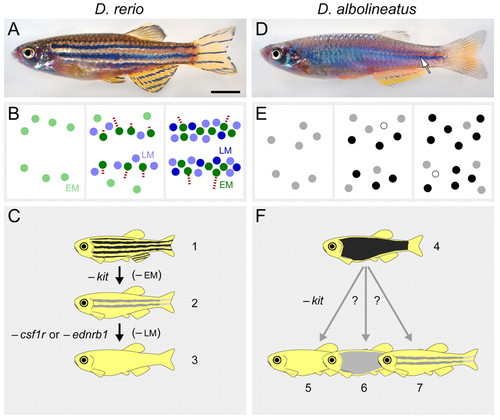Fig. 1
- ID
- ZDB-FIG-070314-49
- Publication
- Mills et al., 2007 - Deconstructing evolution of adult phenotypes: genetic analyses of kit reveal homology and evolutionary novelty during adult pigment pattern development of Danio fishes
- Other Figures
- All Figure Page
- Back to All Figure Page
|
Danio adult pigment patterns, pigment pattern metamorphosis and genetic analyses, either real or envisaged. (A-C) Danio rerio. (A) Wild-type D. rerio exhibit around five melanophore stripes with light interstripes. (B) Early (left) to late (right) stages of adult pigment pattern metamorphosis. EM melanophores (light green) differentiate in a dispersed pattern then migrate (red tracks) toward developing stripes. LM melanophores (light blue) differentiate already at sites of stripe formation. Fully differentiated melanophores within adult stripes come from either EM (dark green) or LM (dark blue) melanophore populations. Other pigment cell classes are omitted for clarity. (C) EM melanophores are kit-dependent, whereas LM melanophores are kit-independent. Wild-type D. rerio (fish 1) with a full complement of melanophores and stripes (black). kit mutant D. rerio (fish 2) lacks EM melanophores but develops residual LM melanophores in stripes (gray) having fewer than wild-type numbers of melanophores. Fish doubly mutant for kit and csf1r or kit and ednrb1 (fish 3) lack body melanophores, as both EM and LM melanophores are missing. (D-F) Danio albolineatus. (D) Wild-type D. albolineatus have melanophores that are nearly uniformly dispersed, although a narrow interstripe is found posteriorly (arrow). (E). Pigment pattern metamorphosis involves the differentiation of initally dispersed melanophores (gray) that show little migratory behavior. Some of these melanophores differentiate fully (black) but many more die (open cells) than in D. rerio (Quigley et al., 2005). (F) Wild-type D. albolineatus (fish 4) with uniformly distributed melanophores (black), and possible phenotypes of kit mutant D. albolineatus. If D. albolineatus have only kit-dependent EM melanophores, a kit mutant should lack melanophores completely (fish 5). If distinct kit-dependent EM and kit-independent LM melanophores are present, however, a kit mutant should develop residual melanophores (fishes 6 or 7) that are fewer than in wild-type (gray uniform pattern or gray stripes). The pattern of these cells would reveal how different populations have contributed to the difference between wild-type D. rerio and wild-type D. albolineatus: if changes only in LM melanophores have occurred, then a kit mutant (lacking EM melanophores) might resemble wild-type D. albolineatus (fish 6); or, if changes only in EM melanophores have occurred, then a kit mutant D. albolineatus (fish 7) should resemble kit mutant D. rerio (fish 3). Fish ages: ∼6 months. Scale bar: in A, 4 mm for A,D. |

